Selected Solutions to Artin’s Algebra, Second Ed.
Takumi Murayama
July 22, 2014
These solutions are the result of taking MAT323 Algebra in the Spring of 2012,
and also TA-ing for MAT346 Algebra II in the Spring of 2014, both at Princeton
University. This is not a complete set of solutions; see the List of Solved Exercises
at the end. Please e-mail takumim@umich.edu with any corrections.
Contents
2 Groups
Laws of Composition . . . . . . . . . . . . . . . . . . . . . . . . . .
2.1
. . . . . . . . . . . . . . . . . . . . . . . . .
2.2 Groups and Subgroups
Cyclic Groups
. . . . . . . . . . . . . . . . . . . . . . . . . . . . . .
2.4
Isomorphisms . . . . . . . . . . . . . . . . . . . . . . . . . . . . . . .
2.6
2.8
Cosets . . . . . . . . . . . . . . . . . . . . . . . . . . . . . . . . . . .
2.10 The Correspondence Theorem . . . . . . . . . . . . . . . . . . . . .
2.11 Product Groups . . . . . . . . . . . . . . . . . . . . . . . . . . . . .
2.12 Quotient Groups . . . . . . . . . . . . . . . . . . . . . . . . . . . . .
6 Symmetry
. . . . . . . . . . . . . . . . . . . . . . . . .
Isometries of the Plane
6.3
6.4
Finite Groups of Orthogonal Operators on the Plane . . . . . . . . .
6.5 Discrete Groups of Isometries . . . . . . . . . . . . . . . . . . . . . .
6.6
Plane Crystallographic Groups . . . . . . . . . . . . . . . . . . . . .
6.7 Abstract Symmetry: Group Operations . . . . . . . . . . . . . . . .
The Operation on Cosets . . . . . . . . . . . . . . . . . . . . . . . .
6.8
6.9
The Counting Formula . . . . . . . . . . . . . . . . . . . . . . . . .
6.10 Operations on Subsets . . . . . . . . . . . . . . . . . . . . . . . . . .
6.11 Permutation Representations . . . . . . . . . . . . . . . . . . . . . .
1
4
4
4
5
7
8
9
9
10
13
13
14
16
17
17
18
19
19
20
�
6.12 Finite Subgroups of the Rotation Group . . . . . . . . . . . . . . . .
6.M Miscellaneous Problems . . . . . . . . . . . . . . . . . . . . . . . . .
11 Rings
11.1 Definition of a Ring . . . . . . . . . . . . . . . . . . . . . . . . . . .
11.2 Polynomial Rings
. . . . . . . . . . . . . . . . . . . . . . . . . . . .
11.3 Homomorphisms and Ideals . . . . . . . . . . . . . . . . . . . . . . .
11.4 Quotient Rings . . . . . . . . . . . . . . . . . . . . . . . . . . . . . .
11.5 Adjoining Elements
. . . . . . . . . . . . . . . . . . . . . . . . . . .
11.6 Product Rings . . . . . . . . . . . . . . . . . . . . . . . . . . . . . .
11.7 Fractions . . . . . . . . . . . . . . . . . . . . . . . . . . . . . . . . .
11.8 Maximal Ideals . . . . . . . . . . . . . . . . . . . . . . . . . . . . . .
11.9 Algebraic Geometry . . . . . . . . . . . . . . . . . . . . . . . . . . .
11.M Miscellaneous Problems . . . . . . . . . . . . . . . . . . . . . . . . .
12 Factoring
12.1 Factoring Integers . . . . . . . . . . . . . . . . . . . . . . . . . . . .
12.2 Unique Factorization Domains
. . . . . . . . . . . . . . . . . . . . .
12.3 Gauss’s Lemma . . . . . . . . . . . . . . . . . . . . . . . . . . . . .
12.4 Factoring Integer Polynomials
. . . . . . . . . . . . . . . . . . . . .
12.5 Gauss Primes . . . . . . . . . . . . . . . . . . . . . . . . . . . . . . .
12.M Miscellaneous Problems . . . . . . . . . . . . . . . . . . . . . . . . .
13 Quadratic Number Fields
13.1 Algebraic Integers . . . . . . . . . . . . . . . . . . . . . . . . . . . .
13.2 Factoring Algebraic Integers
. . . . . . . . . . . . . . . . . . . . . .
13.3 Ideals in Z[
13.4 Ideal Multiplication . . . . . . . . . . . . . . . . . . . . . . . . . . .
. . . . . . . . . . . . . . . . . . . . . . . . . . . . .
13.5 Factoring Ideals
√−5] . . . . . . . . . . . . . . . . . . . . . . . . . . . . .
14 Linear Algebra in a Ring
14.1 Modules
. . . . . . . . . . . . . . . . . . . . . . . . . . . . . . . . .
14.2 Free Modules . . . . . . . . . . . . . . . . . . . . . . . . . . . . . . .
14.4 Diagonalizing Integer Matrices . . . . . . . . . . . . . . . . . . . . .
14.5 Generators and Relations . . . . . . . . . . . . . . . . . . . . . . . .
14.7 Structure of Abelian Groups
. . . . . . . . . . . . . . . . . . . . . .
14.8 Applications to Linear Operators . . . . . . . . . . . . . . . . . . . .
14.M Miscellaneous Problems . . . . . . . . . . . . . . . . . . . . . . . . .
21
23
24
24
25
27
32
33
35
37
38
40
42
45
45
46
50
51
56
59
61
61
62
62
63
63
64
64
65
66
66
67
67
69
2
�
15 Fields
15.2 Algebraic and Transcendental Elements . . . . . . . . . . . . . . . .
15.3 The Degree of a Field Extension . . . . . . . . . . . . . . . . . . . .
15.4 Finding the Irreducible Polynomial . . . . . . . . . . . . . . . . . . .
15.6 Adjoining Roots . . . . . . . . . . . . . . . . . . . . . . . . . . . . .
15.7 Finite Fields . . . . . . . . . . . . . . . . . . . . . . . . . . . . . . .
15.8 Primitive Elements
. . . . . . . . . . . . . . . . . . . . . . . . . . .
15.9 Function Fields . . . . . . . . . . . . . . . . . . . . . . . . . . . . . .
15.10 The Fundamental Theorem of Algebra . . . . . . . . . . . . . . . . .
15.M Miscellaneous Problems . . . . . . . . . . . . . . . . . . . . . . . . .
16 Galois Theory
. . . . . . . . . . . . . . . . . . . . . . . . . .
16.1 Symmetric Functions
16.2 The Discriminant
. . . . . . . . . . . . . . . . . . . . . . . . . . . .
16.3 Splitting Fields . . . . . . . . . . . . . . . . . . . . . . . . . . . . . .
16.4 Isomorphisms of Field Extensions
. . . . . . . . . . . . . . . . . . .
. . . . . . . . . . . . . . . . . . . . . . . . . . . . . . .
16.5 Fixed Fields
16.6 Galois Extensions
. . . . . . . . . . . . . . . . . . . . . . . . . . . .
16.7 The Main Theorem . . . . . . . . . . . . . . . . . . . . . . . . . . .
16.8 Cubic Equations . . . . . . . . . . . . . . . . . . . . . . . . . . . . .
16.9 Quartic Equations . . . . . . . . . . . . . . . . . . . . . . . . . . . .
16.10 Roots of Unity . . . . . . . . . . . . . . . . . . . . . . . . . . . . . .
16.11 Kummer Extensions . . . . . . . . . . . . . . . . . . . . . . . . . . .
16.12 Quintic Equations . . . . . . . . . . . . . . . . . . . . . . . . . . . .
16.M Miscellaneous Problems . . . . . . . . . . . . . . . . . . . . . . . . .
70
70
71
72
73
74
76
77
77
78
81
81
83
86
86
87
88
88
91
92
94
95
95
96
3
�
2 Groups
2.1 Laws of Composition
Exercise 2.1.2. Prove the properties of inverses that are listed near the end of the
section.
Remark. The properties are listed on p. 40 as the following:
(a) If an element a has both a left inverse l and a right inverse r, i.e., if la = 1
and ar = 1, then l = r, a is invertible, r is its inverse.
(b) If a is invertible, its inverse is unique.
(c) Inverses multiply in the opposite order: If a and b are invertible, so is the
product ab, and (ab)−1 = b−1a−1.
(d) An element a may have a left inverse or a right inverse, though it is not
invertible.
Proof of (a). We see l = lar = r.
Proof of (b). Let b, b be inverses of a. Then, b = bab = b, by (a).
Proof of (c). Consider ab. We see that b−1a−1 is the inverse of ab since (b−1a−1)(ab) =
b−1a−1ab = b−1b = 1 by associativity. Uniqueness follows by (b).
Proof of (d). Consider Exercise 2.1.3 below. s is not invertible since it does not have
a two-sided inverse, but it does have a left inverse.
Exercise 2.1.3. Let N denote the set {1, 2, 3, . . .} of natural numbers, and let s : N →
N be the shift map, defined by s(n) = n + 1. Prove that s has no right inverse, but
that it has infinitely many left inverses.
Proof. s does not have a right inverse since s does not map any element of N back
to 1; however, we can define a left inverse rk(n) = n − 1 for n > 1, and rk(1) = k for
some k ∈ N; we see that this is a left inverse of s, i.e., that rk ◦ s = idN. Since k is
arbitrary this implies that there is an infinite number of rk’s.
2.2 Groups and Subgroups
Exercise 2.2.3. Let x, y, z, and w be elements of a group G.
(a) Solve for y, given that xyz−1w = 1.
(b) Suppose that xyz = 1. Does it follow that yzx = 1? Does it follow that
yxz = 1?
4
�
Solution for (a). We claim that y = x−1w−1z. This follows since
x(x−1w−1z)z−1w = xx−1w−1zz−1w = 1.
Solution for (b). Suppose xyz = 1. This implies x−1 = yz, and by Exercise 2.1.2(a),
this left inverse is a right inverse, and so 1 = xyz = x(yz) = (yz)x = yzx.
Now consider yxz; the example
1 1
0 1
0 1
1 0
0
1
1 −1
1 0
0 1
1 −1
1
0
x =
,
y =
,
z =
,
xyz =
,
yxz =
in GL2(R) shows that xyz = 1 does not imply yxz = 1.
Exercise 2.2.4. In which of the following cases is H a subgroup of G?
(a) G = GLn(C) and H = GLn(R).
(b) G = R× and H = {1,−1}.
(c) G = Z+ and H is the set of positive integers.
(d) G = R× and H is the set of positive reals.
(e) G = GL2(R) and H is the set of matrices
a 0
, with a = 0.
0 0
Solution for (a). H is a subset since R ⊂ C implies H ⊂ GLn(R). H is a subgroup
since GLn(R) is a group, hence contains an identity and is closed under multiplication
and inversion.
Solution for (b). H is a subgroup since it is clearly a subset, contains the identity 1,
and −1 × −1 = 1 implies H is closed under multiplication and inversion.
Solution for (c). H is not a subgroup since −1 /∈ H, though it is the inverse of 1.
Solution for (d). H is a subgroup since it is clearly a subset, contains 1, is closed
under multiplication since the product of two positive real numbers is a positive real
number, and since x ∈ H has inverse 1/x ∈ H, which is still positive and real.
Solution for (e). H is not a subgroup since it is not even a subset of G.
2.4 Cyclic Groups
Exercise 2.4.1. Let a and b be elements of a group G. Assume that a has order 7
and that a3b = ba3. Prove that ab = ba.
Proof. ab = aba7 = a(ba3)a4 = a(a3b)a4 = a4(ba3)a = a4(a3b)a = ba.
5
�
Exercise 2.4.3. Let a and b be elements of a group G. Prove that ab and ba have
the same order.
Proof. Suppose (ab)n = 1. We note that b = b(ab)n = (ba)nb, but this implies
(ba)n = 1, and so both have order n.
Exercise 2.4.6.
(a) Let G be a cyclic group of order 6. How many of its elements generate G?
Answer the same question for cyclic groups of order 5 and 8.
(b) Describe the number of elements that generate a cyclic group of arbitrary orders
n.
Solution for (b). By Prop. 2.4.3, if x generates G a cyclic group of order n, another
element xi ∈ G generates G if and only if gcd(i, n) = 1 for 1 ≤ i ≤ n, since then
|xi| = n. Thus, the number of elements that generate G is equal to the number of
numbers less than n that are coprime to n.
Solution for (a). By (b), it suffices to count the number of numbers less than n that
are coprime to n. For 6, {1, 5} are coprime to 6, hence two elements generate the
cyclic group of order 6. For 5, {1, 2, 3, 4} are coprime to 5, hence four elements
generate the cyclic group of order 5. For 8, {1, 3, 5, 7} are coprime to 8, hence four
elements generate the cyclic group of order 8.
Exercise 2.4.9. How many elements of order 2 does the symmetric group S4 con-
tain?
Solution. The order 2 elements of S4 consist of4
= 6 two-cycles, and4
× 1
2
2 = 3
2
products of disjoint two-cycles, and so there are 9 elements of order 2.
Exercise 2.4.10. Show by example that the product of elements of finite order in a
group need not have finite order. What if the group is abelian?
Solution. Consider GL2(R), and the following matrices in GL2(R):
A =
,
B =
−1 1
1 1
0
1
0 1
−1 0
1 n
0
1
.
,
0 1
We see that A2 = B2 = 1, and so they are of order 2, whereas
AB =
and so AB has infinite order.
=⇒ (AB)n =
Now suppose the group is abelian. Suppose a, b are our elements of finite order,
of order n, m respectively. Then, (ab)nm = anmbnm = (an)m(bm)n = 1, and so ab is
necessarily of finite order.
6
�
Isomorphisms
2.6
Exercise 2.6.2. Describe all homomorphisms ϕ : Z+ → Z+. Determine which are
injective, which are surjective, and which are isomorphisms.
Solution. By the definition of homomorphism, for all positive n ∈ Z+, we have
, ϕ(−n) = −ϕ(n), ϕ(0) = ϕ(n) + ϕ(−n) = 0.
ϕ(n) = ϕ(1) + ··· + ϕ(1)
n times
Thus, ϕ is fully determined by what 1 maps to. By the above, we then have that ϕn :
z nz for n ∈ Z+ are all the homomorphisms of Z+. The injective homomorphisms
consist of those ϕn for n = 0. The surjective homomorphisms consist of those ϕn for
n = ±1; these are also the isomorphisms of Z+ since they are injective.
Exercise 2.6.3. Show that the functions f = 1/x, g = (x− 1)/x generate a group of
functions, the law of composition being composition of functions, that is isomorphic
to the symmetric group S3.
Solution. We define
f1 = x,
1 − x
Then, we can construct the multiplication table:
f4 =
f2 =
1
x
,
f3 = 1 − x,
1
,
f5 =
x
x − 1
,
f6 =
x − 1
x
.
f1 f2 f3 f4 f5 f6
f1 f1 f2 f3 f4 f5 f6
f2 f2 f1 f4 f3 f6 f5
f3 f3 f6 f1 f5 f4 f2
f4 f4 f5 f2 f6 f3 f1
f5 f5 f4 f6 f2 f1 f3
f6 f6 f3 f5 f1 f2 f4
This proves closure since every combination of factors is accounted for, identity since
every row/column contains e = f1, and associativity since associativity holds for
composition of rational functions. We claim that this is isomorphic to S3. This
follows since if we let f1 e, f2 (12), f6 (123), we get the following table:
e
e
(12)
(13)
(132)
(23)
(123)
(12)
(12)
e
(123)
(23)
(132)
(13)
e
(12)
(13)
(132)
(23)
(123)
(132)
(132)
(13)
(23)
(123)
(12)
e
(23)
(23)
(123)
(132)
(13)
e
(12)
(123)
(123)
(23)
(12)
e
(13)
(132)
(13)
(13)
(132)
e
(12)
(123)
(23)
7
�
This proves it is a homomorphism since all of the multiplications are accurate, and
is an isomorphism since every element in S3 is mapped to, with inverse defined by
matching entries. This shows f2, f6 generate the group of functions since (12), (123)
generate S3 as on p. 42.
1 1
1
Exercise 2.6.6. Are the matrices
1 1
GL2(R)? Are they conjugate elements of SL2(R)?
1
,
conjugate elements of the group
Solution. We explicitly calculate the conjugation for the conjugation matrix A:
a11 a12
1 1
a11 a11 + a12
a21 a22
0 1
=
=
1 0
1 1
a11 a12
a21 a22
a12
a11
a21 a21 + a22
a11 + a21 a12 + a22
This equality requires a11 = 0, a12 = a21; however, we see that then det A < 0 in this
case, so the matrices are not conjugate in SL2(R).
We see that they are, however, conjugate elements of the group GL2(R), since
0 1
1 1
1 0
0 1
1 1
1 0
.
=
1 0
0 1
2.8 Cosets
Exercise 2.8.4. Does a group of order 35 contain an element of order 5? of order
7?
Solution. Any element in G has order in {1, 5, 7, 35} by Cor. 2.8.10. Suppose G
had no elements of order 5; then, all non-identity elements must have order 7, for if
|x| = 35, then |x7| = 5. Let h have order 7, and H = h; since |H| = 7, pick g /∈ H.
Then, g = e and has order 7. The left cosets H, gH, g2H, . . . , g6H must be disjoint,
for, if gahi = gbhj, then ga−b = hi−j, and so picking r such that r(a − b) ≡ 1 mod 7,
we have that g = gr(a−b) = hr(i−j) ∈ H, a contradiction. But this contradicts the
counting formula (2.8.8), since |G| = 35 = 49 = 7· 7 = |H|[G : H], and so G contains
an element of order 5.
Now suppose G had no elements of order 7; then all non-identity elements have
order 5 as before. Letting h have order 5 and H, g as before, the same argument gives
that H, gH, g2H, . . . , g4H are disjoint left cosets in G. This contradicts the counting
formula (2.8.8) again, since |G| = 35 = 25 = 5 · 5 = |H|[G : H], hence G contains an
element of order 7.
8
�
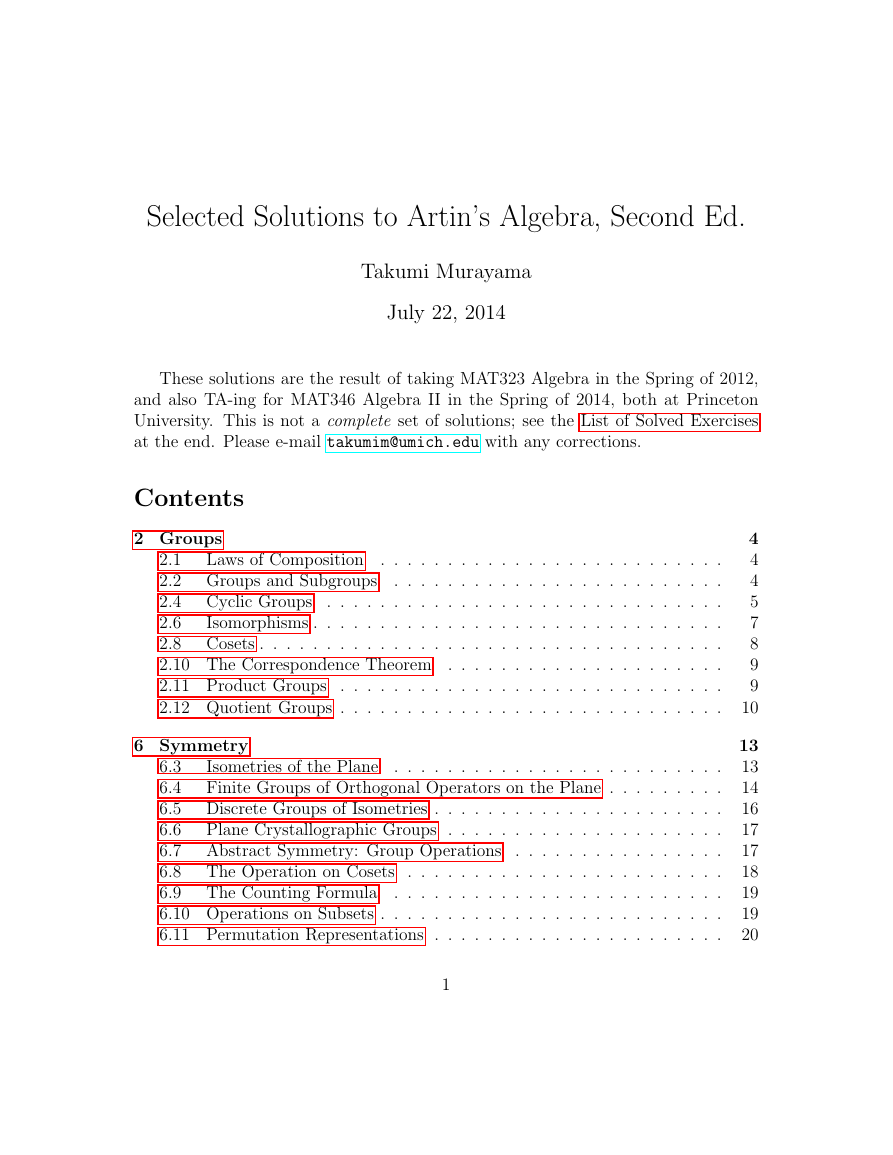
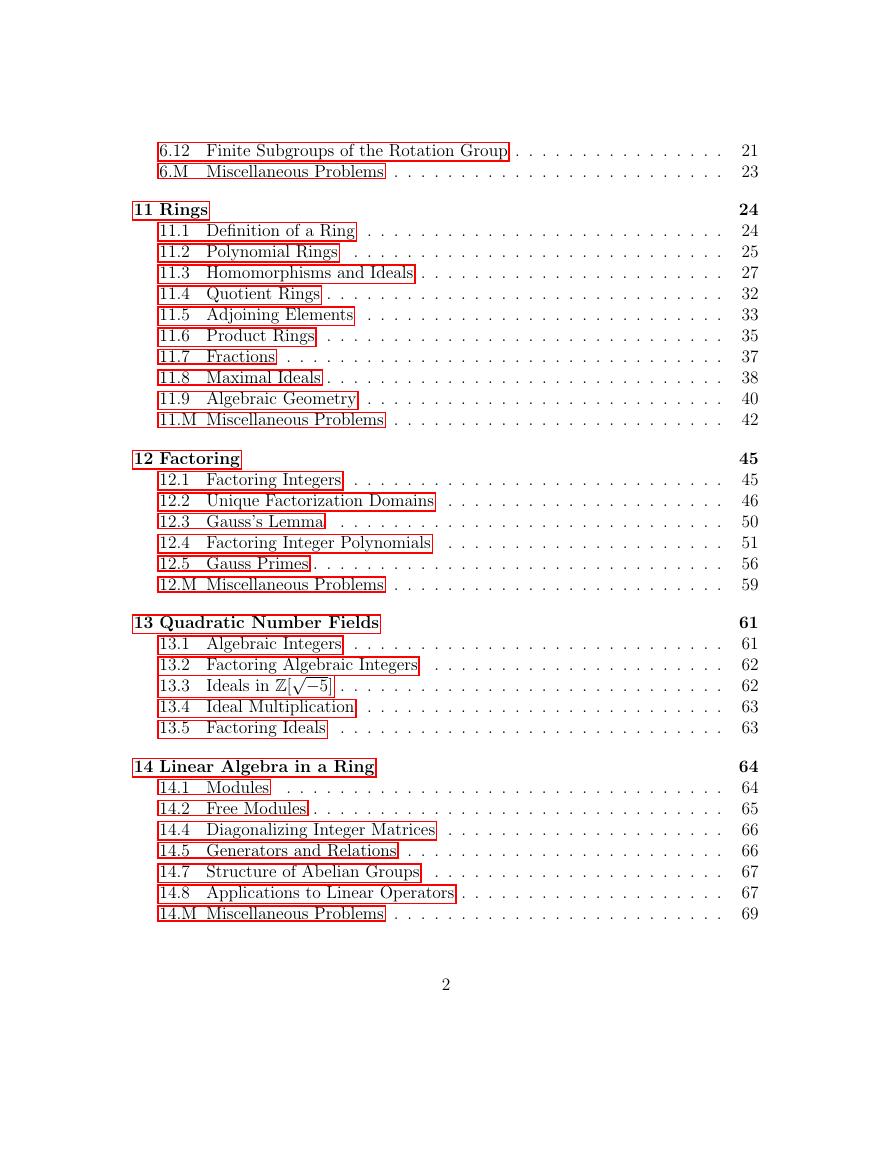
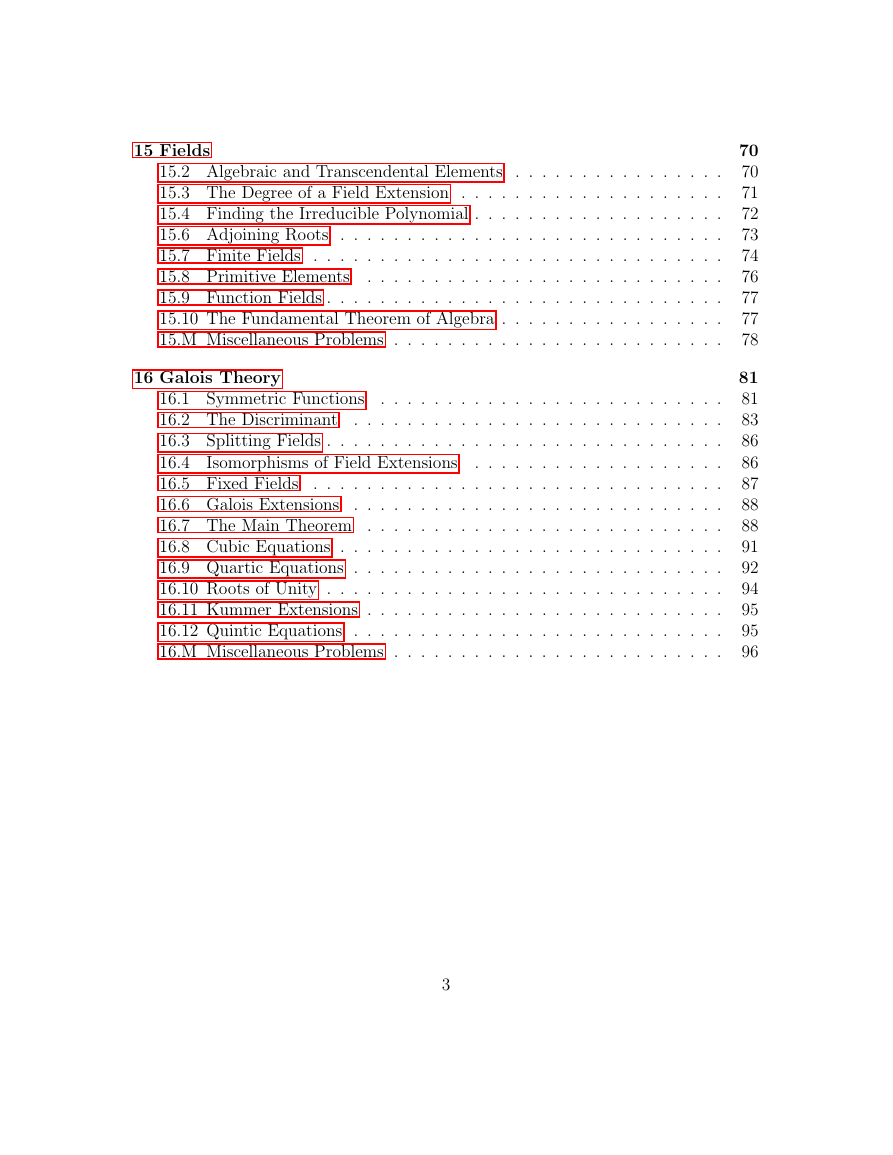
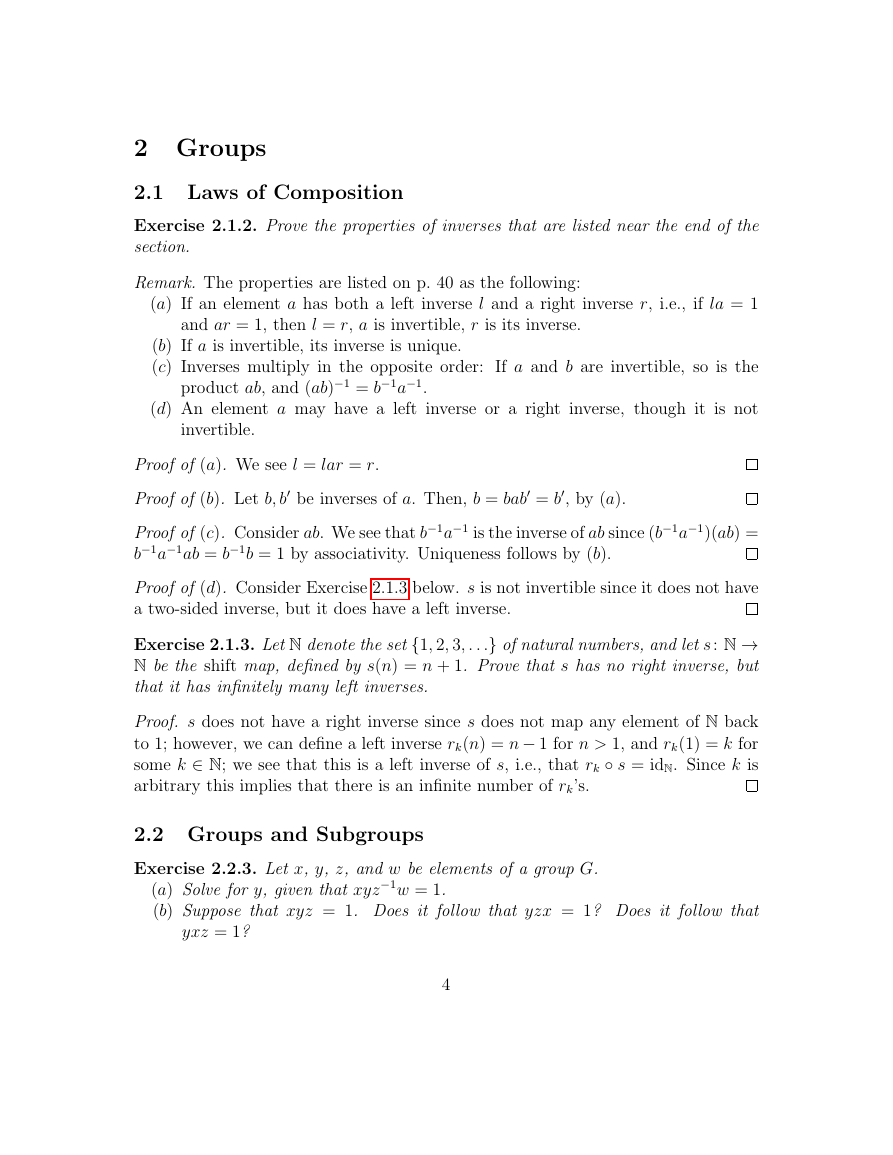
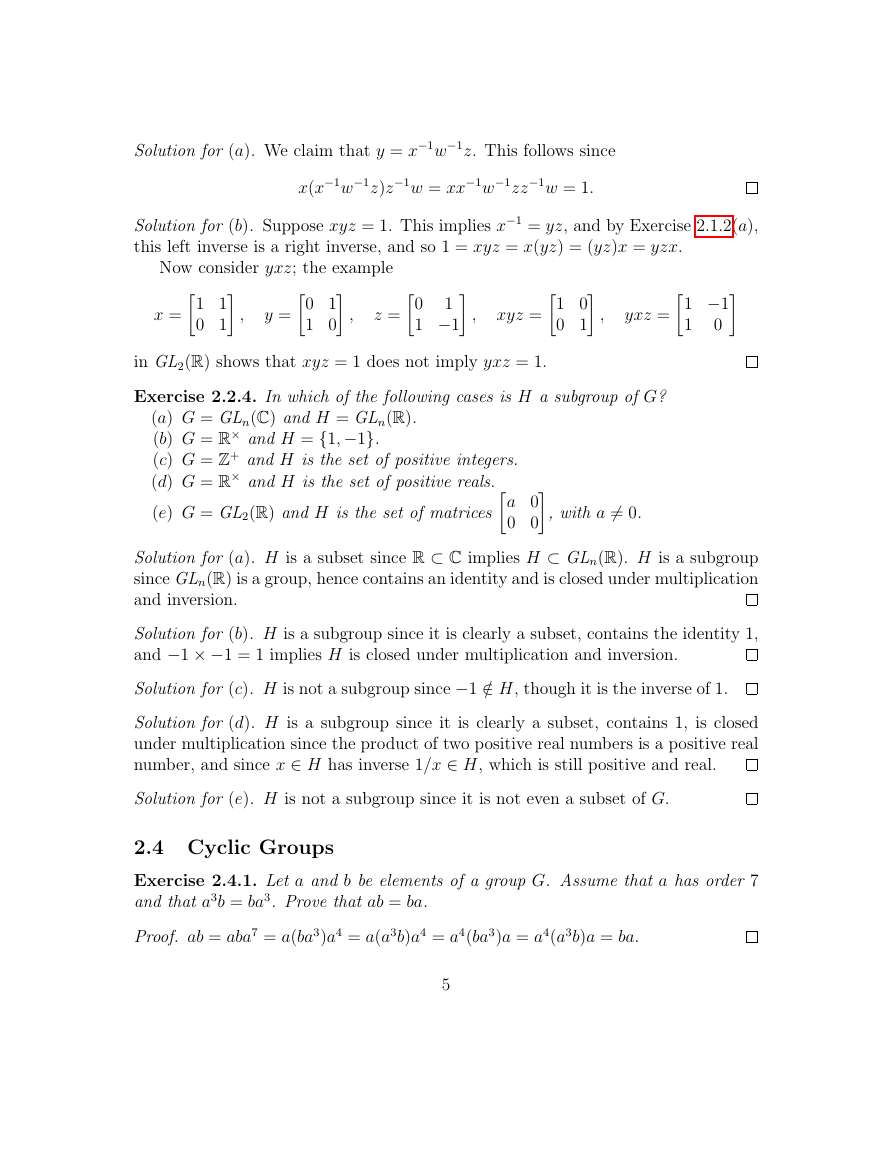

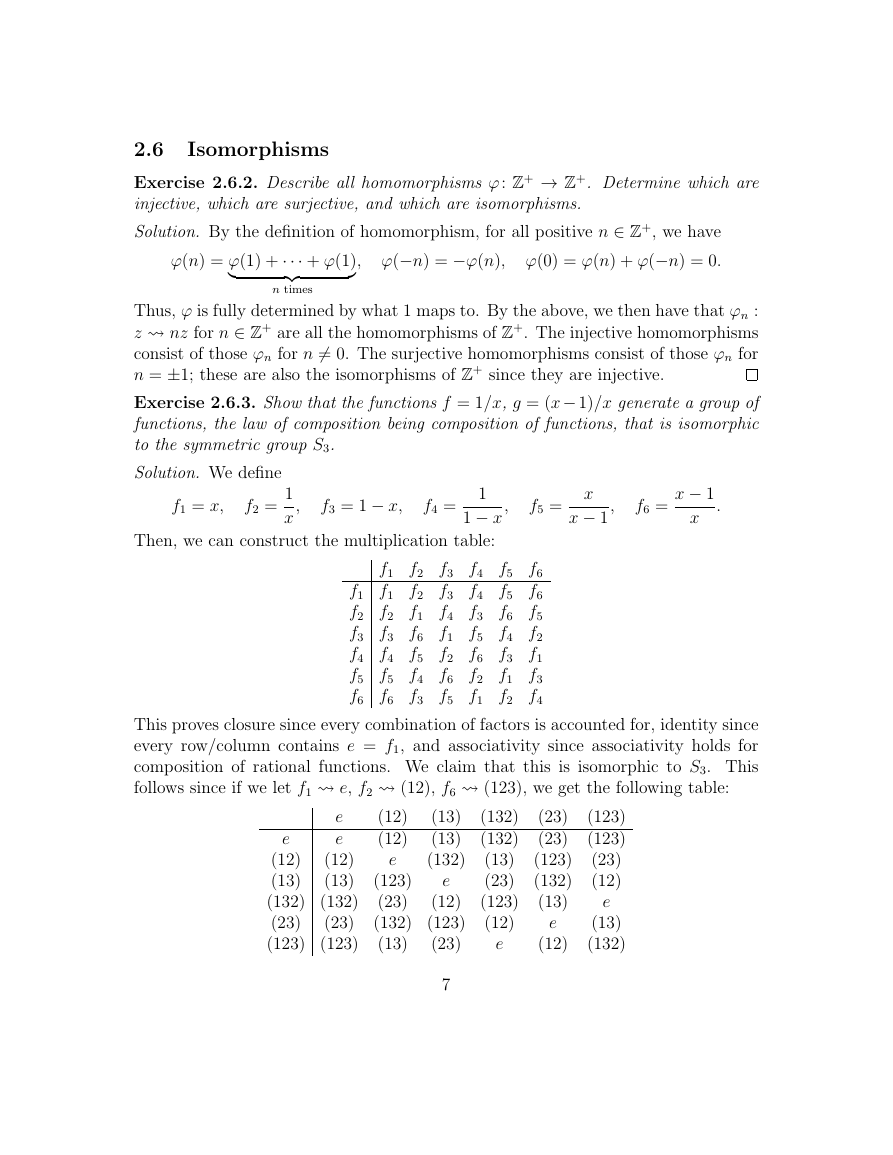
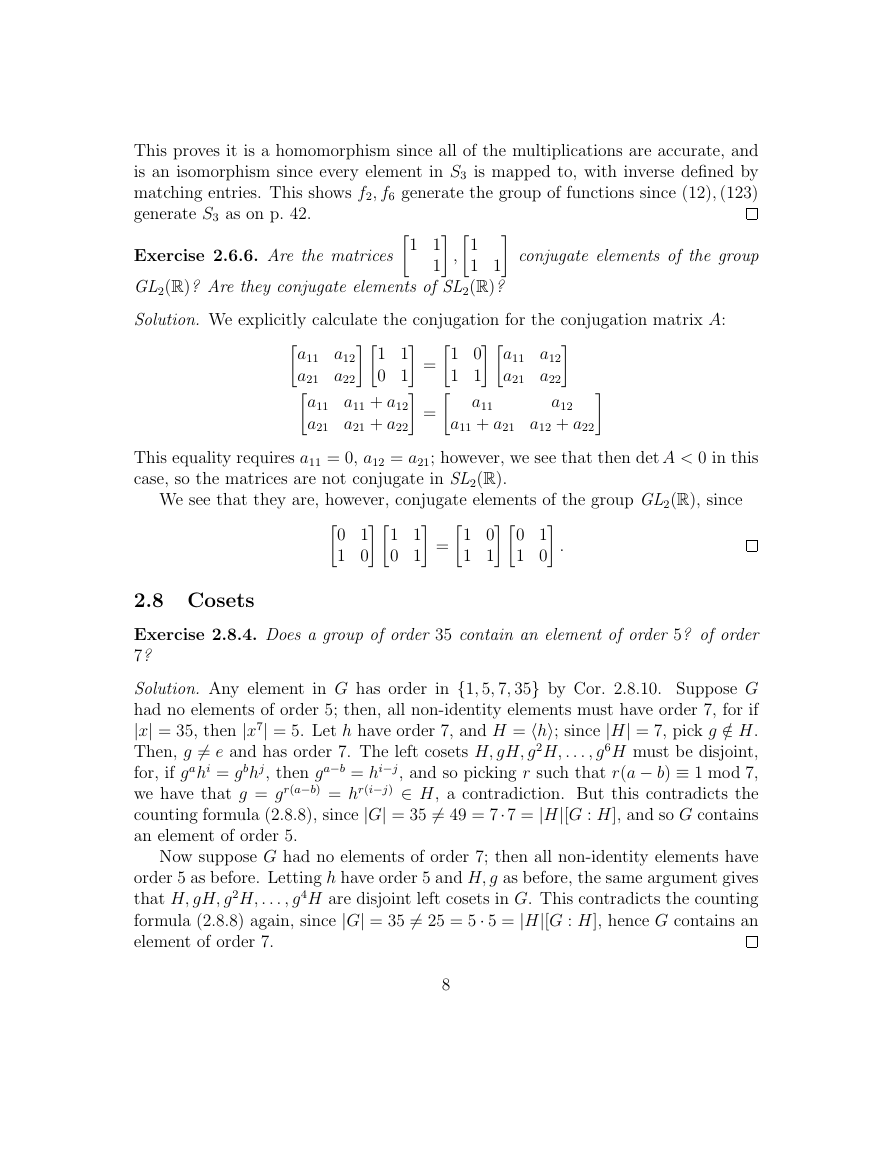








 2023年江西萍乡中考道德与法治真题及答案.doc
2023年江西萍乡中考道德与法治真题及答案.doc 2012年重庆南川中考生物真题及答案.doc
2012年重庆南川中考生物真题及答案.doc 2013年江西师范大学地理学综合及文艺理论基础考研真题.doc
2013年江西师范大学地理学综合及文艺理论基础考研真题.doc 2020年四川甘孜小升初语文真题及答案I卷.doc
2020年四川甘孜小升初语文真题及答案I卷.doc 2020年注册岩土工程师专业基础考试真题及答案.doc
2020年注册岩土工程师专业基础考试真题及答案.doc 2023-2024学年福建省厦门市九年级上学期数学月考试题及答案.doc
2023-2024学年福建省厦门市九年级上学期数学月考试题及答案.doc 2021-2022学年辽宁省沈阳市大东区九年级上学期语文期末试题及答案.doc
2021-2022学年辽宁省沈阳市大东区九年级上学期语文期末试题及答案.doc 2022-2023学年北京东城区初三第一学期物理期末试卷及答案.doc
2022-2023学年北京东城区初三第一学期物理期末试卷及答案.doc 2018上半年江西教师资格初中地理学科知识与教学能力真题及答案.doc
2018上半年江西教师资格初中地理学科知识与教学能力真题及答案.doc 2012年河北国家公务员申论考试真题及答案-省级.doc
2012年河北国家公务员申论考试真题及答案-省级.doc 2020-2021学年江苏省扬州市江都区邵樊片九年级上学期数学第一次质量检测试题及答案.doc
2020-2021学年江苏省扬州市江都区邵樊片九年级上学期数学第一次质量检测试题及答案.doc 2022下半年黑龙江教师资格证中学综合素质真题及答案.doc
2022下半年黑龙江教师资格证中学综合素质真题及答案.doc